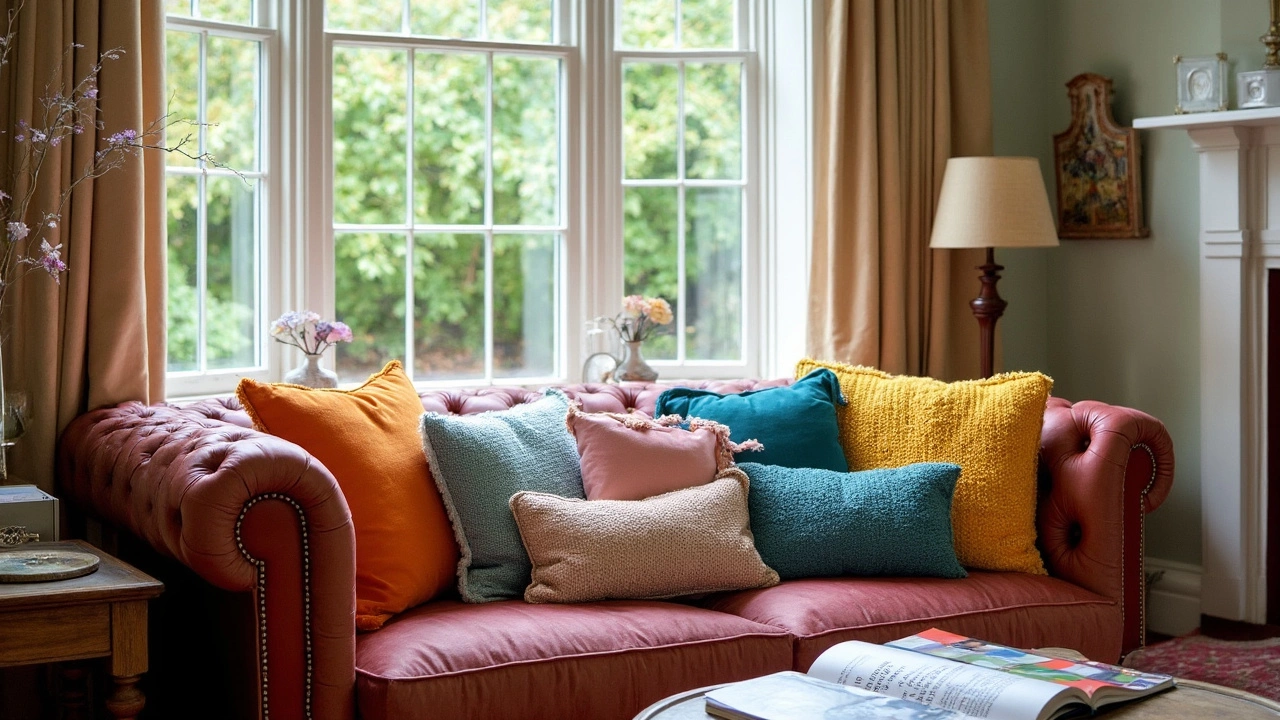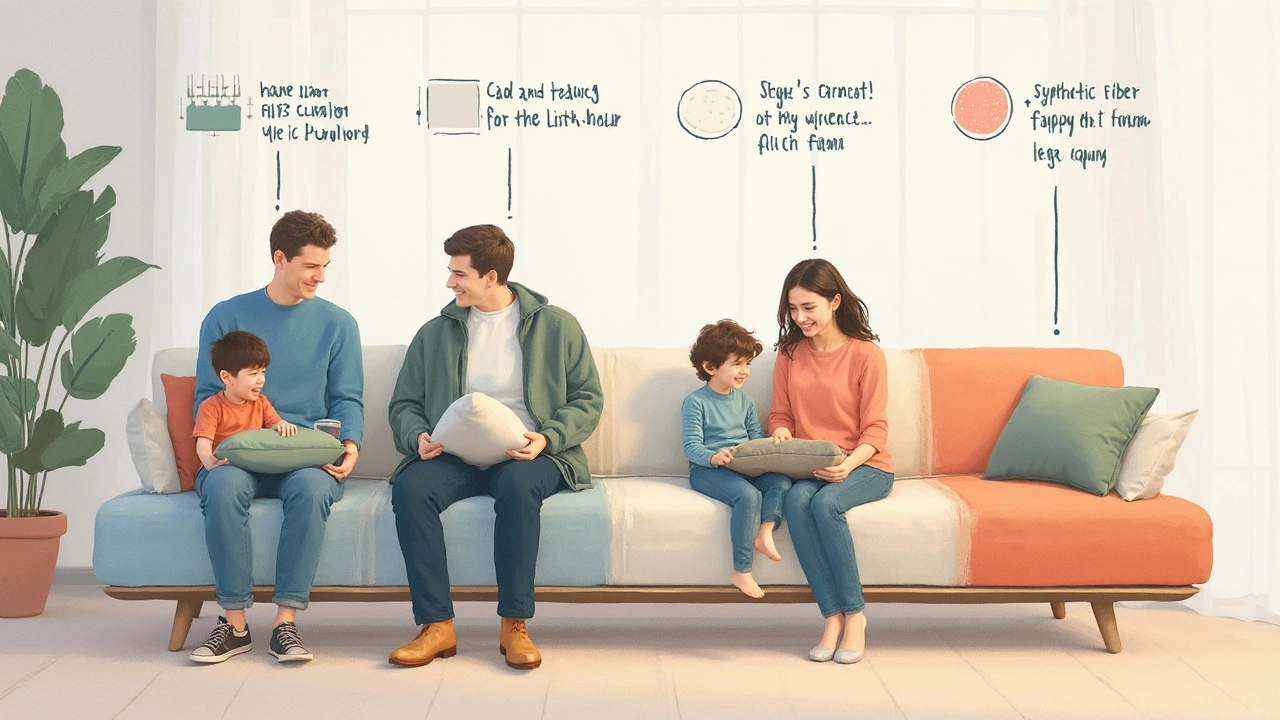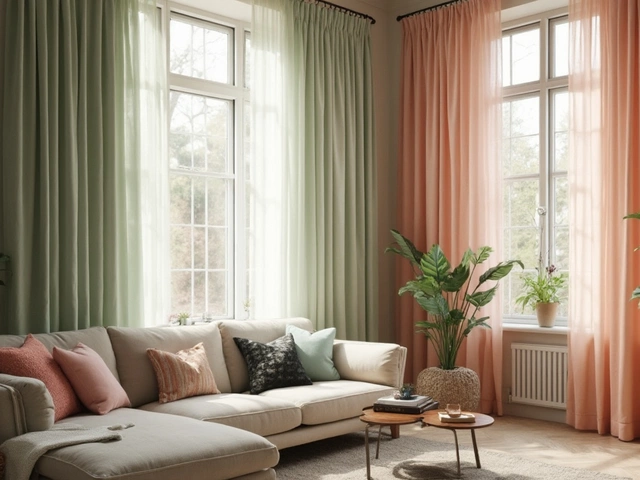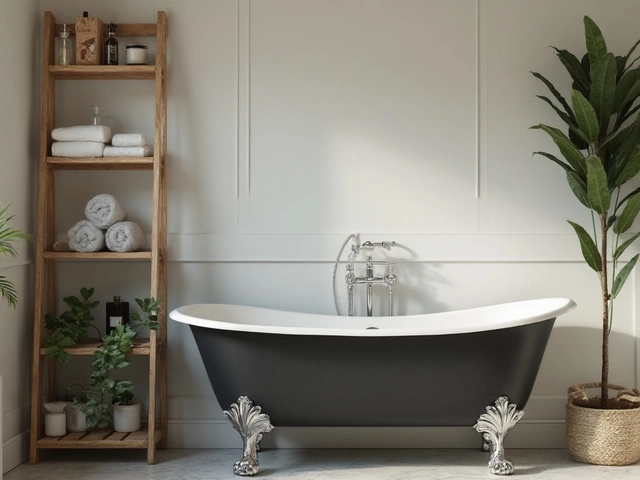
Ever sat down on a couch and felt like it instantly swallowed you, or did the opposite and was so stiff you might as well have sat on a bench? A lot of that comes down to what’s inside those cushions—and what kind of covers are used. If you’re thinking about swapping out your old cushions or adding a few more, you can’t just grab the first ones you see at the store.
The right cushion can make your Netflix sessions better, your napping easier, and even save your back. Some cushions give you that soft, sink-in feeling while others give you firm support that actually helps you get up without groaning. There isn’t just one right answer. It depends a lot on how you use your couch—and what kind of look you’re going for. Your lifestyle, pets, and how messy your kids are all matter too.
You’ll notice terms like “polyester fill,” “down feather,” or “memory foam” thrown around. Each has its pros and cons, and knowing the difference saves you money—and regrets—later. Sometimes just changing the shape or the fill type totally changes the vibe (and comfort level) of your couch. Ready to ditch those lumpy old pillows? Let’s get into the real stuff you should look for when picking sofa cushions that won’t drive you nuts.
- Different Types of Sofa Cushions
- Best Cushion Fills for Comfort and Support
- Shapes and Sizes: Picking What Fits
- Cushion Covers: Durability and Style
Different Types of Sofa Cushions
If you’ve ever shopped for sofa cushions, you know the options seem endless. But in reality, there are a few main types you’ll see over and over—each with its own perks and downsides.
The standard is the box cushion, which basically means a straight-edged, squared-off cushion with sharp corners. You’ll spot these on most modern couches because they give that crisp, tailored look. These are easy to clean, flip, and stack up evenly, so if you want low-maintenance, box cushions are a safe bet.
Then there’s the T-cushion, which is shaped like a letter “T” where it wraps around the arm of the couch. These are common on traditional sofas and loveseats. They’re good if you like an armrest you can lean on without losing your pillow to the gap. It does mean fewer options for flipping, but the extra comfort at the arms can be worth it if you sprawl out.
Bench cushions are another style—these are single long cushions that run the whole length of the seat. They give a sleek, minimal look and are awesome if you hate falling into cracks between seat cushions. But just know: they can shift more, and if you’ve got kids jumping around, you’ll be fixing them more often.
If you’re thinking about style, scatter or throw cushions let you mix and match all you want. These aren’t the main seating cushions, but they’re key to making any couch comfier and more personal. People usually grab multiples, mixing sizes and colors to bring a room together.
Here’s a quick look at how the main cushion types match up:
| Cushion Type | Common Use | Pros | Cons |
|---|---|---|---|
| Box Cushion | Most sofas | Clean look, flips easily | Not always the softest |
| T-Cushion | Traditional sofas | Extra space at arms | Limited flipping |
| Bench Cushion | Modern/Minimal sofas | No seat gaps, sleek style | Tends to slide |
The bottom line: your choice really depends on how you use your couch—and how much time you want to spend fixing cushions every day. Thinking about who sits on your couch and how they use it helps a ton when picking the right type.
Best Cushion Fills for Comfort and Support
What’s actually inside your sofa cushions matters way more than you’d think. The fill is the make-or-break factor for how a couch feels and how it holds up. Here’s the real breakdown of what people are using and why it works—or doesn’t.
Polyester Fiberfill is basically the go-to for budget couches, and sometimes for decorative pillows. It’s cheap, hypoallergenic, and keeps its shape for a while. The catch? It flattens out fast. If you’ve ever noticed your cushions losing their spring in six months, blame the polyester fill. Still, it’s easy to fluff up and wash, which makes it a safe choice if you don’t want to overthink things.
If you want that super-plush, luxury vibe, Down Feather fills are the classic. They feel like you’re melting into the couch, but here’s the deal: the feathers tend to move around, so you’ll be fluffing these every couple of days. Allergies can also be an issue for some people. Down blends (usually down mixed with foam or fiber) do a better job of springing back and giving you support, without the constant fluffing.
Foam is all about support. High-density foam in couch comfort cushions won’t cave in after a few months, which is why most better-made couches use it. The firm, bouncy feel helps your body, especially your back, hold a good posture when you sit. Memory foam, a newer option, molds to you for extra comfort but can get hot, especially in the summer.
Some cushions combine these fills for the best of both. A common mix is foam at the core with a layer of soft fiber or feathers on top. This way, you get both support and squishiness. Here’s a quick cheat sheet to compare:
| Type | Feel | Best For | Downsides |
|---|---|---|---|
| Polyester Fiberfill | Soft, springy | Decorative or budget couches | Flattens fast |
| Down Feather | Super plush | Lounging, luxury vibe | Requires fluffing, can cause allergies |
| Foam | Firm, supportive | Everyday use, back support | Can feel stiff if too dense |
| Blends | Balanced | Comfort seekers, families | Usually pricier |
If your home decor is built around people actually using the couch, go for a foam core with a soft outer layer. It won’t just look good—it’ll survive those marathon movie nights and kids climbing all over it. And if you’re the type who likes to lay down and nap, nothing beats a soft feather blend. Watch for allergies and always check that your covers come off easily, because some fills can’t be washed.

Shapes and Sizes: Picking What Fits
This is where most people mess up with sofa cushions. They either go too big, and it looks like a pillow fight waiting to happen—or way too small, so you’re always shifting around to get comfy. The best cushions make your couch look balanced while actually letting you stretch out or kick back the way you want.
If you want something classic, stick with square cushions. They’re the most popular, easy to mix and match, and work for both sitting up and lying down. Need back support or want to add some interest? Throw in a lumbar cushion. Those long, skinny ones are life savers for keeping your lower back happy.
Circular or round cushions are trending right now. You’ll usually see them as accents—just don’t overdo it or your couch will start looking like a circus tent. If you have a big sectional, try mixing rectangles, squares, and rounds for a lived-in, casual feel that still looks designed.
Getting the size right is half the battle. Standard sofa cushions should be around 18–20 inches square, but measure your couch first. For smaller love seats, 16-inch pillows won’t crowd the space. On deeper sectionals, jumbo 22–24 inch cushions look proportional and make it easy to relax.
| Couch Type | Recommended Cushion Size |
|---|---|
| Standard Sofa | 18–20 inches |
| Loveseat | 16–18 inches |
| Deep Sectional | 22–24 inches |
Spacing matters too. For a regular three-seater, two to four cushions is the sweet spot—enough to look cozy, but not so many you’re tossing them on the floor every time you sit down. Sectionals or larger couches can handle more, especially if you like to layer looks with different shapes and colors.
- Take a measuring tape to your couch—not just eyeball it.
- Don’t mix too many patterns; stick to one or two solid colors plus a pop of something fun.
- Try arranging cushions in odd numbers (like 3 or 5) for a more natural, relaxed style.
If your couch is extra deep or your family loves lounging, an oversized bolster cushion (basically a big tube) adds serious support and doubles as a footrest. The bottom line: the right couch comfort and style comes from shapes and sizes that actually fit your furniture and your life, not just what’s on sale this week.
Cushion Covers: Durability and Style
If your sofa cushions always look worn out, chances are the covers aren’t right for your lifestyle. Choosing the right cushion cover is not just about matching your living room. It’s about surviving pizza nights, kids’ crayons, or even your dog’s muddy paws. You want something that holds up without looking sad after only a few months.
Start with fabric. Here’s the rundown:
- Cotton: Super comfy, but stains easily and isn’t the toughest against roughuse from pets or kids.
- Polyester blends: These are the real workhorses. They resist fading, pile, and stains much better. Great for families or high-traffic couches.
- Microfiber: Don’t shrug this off—it’s stain-resistant and feels pretty nice. If you spill things (or have toddlers who do) this stuff forgives a lot.
- Leather: Easy to wipe clean, but can crack or wear out if you don’t moisturize it. It also gets hot in summer and cold in winter, so keep that in mind.
- Velvet: Has that fancy look, but traps pet hair and shows every crumb. Looks stunning if you don’t mind the extra cleaning.
Another thing that matters: how easy the covers are to clean. Zippered, removable covers are a lifesaver. Nobody wants to scrub stains while the cushion is stuck on the couch. Machine-washable covers save you money because you can toss them in the wash when mess happens instead of replacing the whole thing.
For those worried about durability, look for a fabric’s "Martindale rub test" rating. A score over 20,000 means the fabric can survive daily use without looking shabby. Here’s a quick cheat sheet for common fabric durability:
| Cover Material | Average Martindale Score | Best For |
|---|---|---|
| Polyester Blend | 25,000–50,000 | High-traffic living, pets, kids |
| Cotton | 10,000–15,000 | Occasional use, no pets |
| Microfiber | 30,000+ | Spills, daily use |
| Velvet | 20,000–35,000 | Style, not heavy use |
Finally, don’t forget about style. Solid colors give a clean look and make it easy to swap out throws and pillows. Bold patterns or textures can hide stains and bring a little personality if your decor feels too plain. If you get bored easily, stick with neutral covers and just rotate colorful accent cushion covers when you want to mix things up.
The right cushion covers for your couch mean fewer headaches and more flex—whether it’s movie night or your in-laws are visiting. Pick a fabric that fits your real life, not the life Instagram says you should have. You’ll be happier for it.




